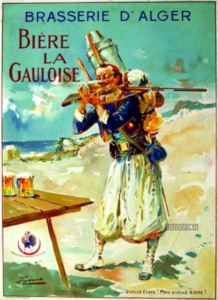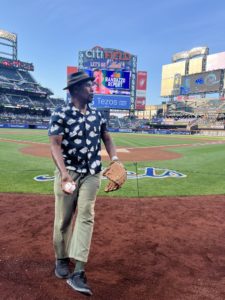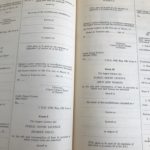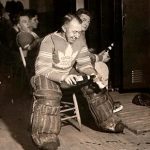 Finally… nothing like seeing the end of November. My least favourite month. I used to always dread it. Days gloomily shortening. School papers needing to be put properly in hand. Time now to look forward, to the holidays. To life with family and friends, gathering inside. While not directly Christmassy, Max posted two images of insidey painting, each of which illustrate the excellence of non-brewing records to inform us about brewing history. In the first, “Vesnická Hospoda”, a 1863 painting by Czech artist Quido Mánes we have a tavern scene with a discussion being held by all ages. The beer glows. And not unlike today in a way… just the sort of thing that I was looking for in the 2006-15 beer blog Yuletide, Kwanzaa, Hogmanay, Christmas and Hanukkah photo contest. I sifted through hundreds of entries every year looking for a glow just like that to ensure all the pressies were directed to all the wee beer nerds’s stockings. Many of the entries are still saved at the Wayback Machine.
Finally… nothing like seeing the end of November. My least favourite month. I used to always dread it. Days gloomily shortening. School papers needing to be put properly in hand. Time now to look forward, to the holidays. To life with family and friends, gathering inside. While not directly Christmassy, Max posted two images of insidey painting, each of which illustrate the excellence of non-brewing records to inform us about brewing history. In the first, “Vesnická Hospoda”, a 1863 painting by Czech artist Quido Mánes we have a tavern scene with a discussion being held by all ages. The beer glows. And not unlike today in a way… just the sort of thing that I was looking for in the 2006-15 beer blog Yuletide, Kwanzaa, Hogmanay, Christmas and Hanukkah photo contest. I sifted through hundreds of entries every year looking for a glow just like that to ensure all the pressies were directed to all the wee beer nerds’s stockings. Many of the entries are still saved at the Wayback Machine.
 In the world of beer culture politics, British beer home delivery service Beer 52 had to issue a statement concerning some flack it had received over a poor PR decision that received some heat. Click on the image to the right to have a look. This is one of the odder but very consistent themes I’ve seen over the years that perhaps distinguishes UK craft from others – the need to not be too nasty to the competition. At a certain point, craft beer shops and craft beer home delivery service are hunting for the same shillings and guineas lodged in the purses of the nation. But, on the other hand, it is nice to be nice.
In the world of beer culture politics, British beer home delivery service Beer 52 had to issue a statement concerning some flack it had received over a poor PR decision that received some heat. Click on the image to the right to have a look. This is one of the odder but very consistent themes I’ve seen over the years that perhaps distinguishes UK craft from others – the need to not be too nasty to the competition. At a certain point, craft beer shops and craft beer home delivery service are hunting for the same shillings and guineas lodged in the purses of the nation. But, on the other hand, it is nice to be nice.
The British Beer Writers Guild were also in a manner of speaking required to issue its own statement of sorts, as the Guild’s top judging dog explained the almost Byzantine judging process in response to the howls which usually follow this sort of thing. I’d post a quote from the explanation but it does go on and one. Great transparency. No, I will share two bits:
This year the awards were judged by me, a publican from York, a committee member of the British Institute of Innkeeping, a magazine editor, a brewer, a beer importer, two freelance journalists (an unusually high number) a book publisher, and a cheesemonger. Hardly beer writers slapping each other’s backs… We usually have 13-14 categories, and this year there were a total of 190 different entries. That’s far too much for any one judge to read, so judges are paired up and given a few categories each.
Did you know I used to receive a few abusive responses for the photo contest? No? Did I care? Not much. My only recommendation was that this explanation of the process might have been shared prior to outset but, you know, what can you do? It is an unfortunate situation and in large part based on honest deep disappointment as much as gratuitous slag* – but Martyn has been checking the stats and decided that this year’s British Beer Writer of the Year Jonny Garrett is now the most successful contestant in the award’s last ten years. So that’s something. Oh, and madman Gary crossed the Atlantic to sit in on the awards and enjoyed himself very much.
There, that’s enough of that statement making stuff. Care of Mudgie, we learn of Bernard Bland, 92, of Grimsby:
When Bernard Bland made his first trip to the Nunsthorpe Tavern in 1954, a pint set him back eight shillings and 10 pence – or the equivalent of 45p. Yet despite the rising cost of a pint, Bernard is still going to his beloved Grimsby boozer 68 years later. In fact, the 92-year-old has been going there every day for seven decades – only missing his daily session when the pub closed during lockdown.
Not as regular in his pubbing habits – but who could be – this week Cookie wrote about his relationship to the pub at one of the sadder moments in life, the passing of a parent:
But life adjusts and new normals and patterns emerge. A worry for my father in living alone after 45 years of marriage led to spending much more time with my father to assist in his living, eat a meal or two a week with him, shop and administer things. Run 2 houses and lives in a way. Not a burden in any way, but a rekindling of a friendship that in its way has defined me more than any other. Thus, I ended up on a saunter around the pubs of Reddish. In truth I rarely pop in pubs these days, a couple on a Saturday afternoon in Wetherspoons being more or less it when a quiet couple of hours is needed. People don’t talk to you in Wetherspoons. You can just sink a pint.
Eric Asimov wrote an interesting piece in the NYT on the nature of a “wine bar” – which is also something I have thought about in relation to identifying as a “beer bar” as opposed to a bar:
Are they all wine bars? Or is the term so vague as to be meaningless? It might depend on whom you ask… Good wine bars are informal neighborhood gathering places rather than destinations, with occasional exceptions, like when a wine list is so deep that it draws in the trophy- and rare-bottle hunters. But mostly, they are places to drop in near one’s home. They might take some reservations, but they always have room for walk-ins. Wine bars mostly cater to young people. At almost every place I visited, I was by far the oldest patron there.
Don Cazentre wrote about something I had not thought about before – relative stats on which US community out drinks the others on bars at US Thanksgiving, something his hometown of Syracuse, NY has excelled at before:
The night before Thanksgiving, sometimes called Drinksgiving, is typically one of the busiest evenings for bars across the country. And the Syracuse area is often one of the leaders. That held true again this year, as the Syracuse market once again stood out, according to data from BeerBoard, an Armory Square-based company that manages and collects stats and information from draft beer accounts nationwide.
Do they also use gallon-sized tankards there like in the British Iron Age? The Tand himself has written on the subject of a smaller sort of vessel, Sam Smith’s proprietor, Humphrey Smith and the question of how steady his hand is upon the tiller:
…all is not well. I was told, recently, that no fewer than 120 Sam Smith’s pubs are closed through lack of people to run them. (You can often find them listed in trade adverts for managers) This is an astonishing number given that all of them are managed houses, and while they attract a smallish salary, not much above minimum wage, but they do have heating, lighting and rent thrown in on top. This is not an entirely unattractive package in these dodgy times, so why is there a problem in finding the right people to run them?
Jeff added thoughts from afar including the bluntly stated “no one drinks English ales anymore” which is hard to deny… except for the fact that they do.
Stan’s Hop Queries newsletter for November 2022 has landed on my driveway in a neat plastic wrapper and he has noted the end of the line for one particular strain:
CLS Farms has eliminated Medusa, the neomexicanus-only hop that introduced American brewers to a botanical variety of Humulus lupulus that produces unique aromas in beer, from its portfolio. Plants were “grubbed out” after the 2022 harvest. Before you ask, the future still looks fine for Zappa, a daughter of Medusa, being grown on six farms in five states. “It is time to focus on Zappa and let Medusa go,” CLS co-owner Eric Desmarais wrote via email. Quite simply, Medusa didn’t measure up agronomically. “(Medusa) doesn’t have the yield to be able to be super viable moving forward in a higher inflationary world, and a much more competitive hop variety landscape,” Desmarais wrote.
Bit of World Cup news even with the ban – the soak was on in Qatar and “bars overestimated surge pricing”:
Beer prices in Qatar could fall after some bars “overestimated what they can get away with” charging during the World Cup, according to a fans’ group. Supporters visiting the Gulf state say they have faced prices of up to £15 for a pint during the tournament, although many have found it cheaper and venues have offered deals.
The gouge is one elsewhere too with some UK pubs offering lower alc% beers at higher prices in the New Year.
And, finally, a Mastodon update. Now up to 573 followers after the blog was linked to one of those likely list compilers. Incuration, that’s what I call it. Seems I am incurable. Shocking. Still, I am looking more there than with the Twit. It’s happening. Please join us all at @agoodbeerblog@mstdn.social.
That’s it for this week and that month. As we move into December, please check out the updates from Boak and Bailey hopefully now again mostly every Saturday and also from Stan more now on a Monday than almost ever! Check out the weekly and highly recommented Beer Ladies Podcast. The OCBG Podcast is on a very quiet schedule these days – but it’s coming back soon. See also sometimes, on a Friday, posts at The Fizz as well (Ed.: we are told ‘tis gone to 404 bloggy podcast heaven… gone to the 404 bloggy podcast farm to play with other puppies.) And the long standing Beervana podcast (Ed.: which I have missed from this list for some unknown reason.) There is the Boys Are From Märzen podcast too and check out the travel vids at Ontario’s own A Quick Beer. There is a monthly sort of round up at The Glass. (Ed.: that seems to be dead now… nope, there was a post on July 25th… in 2022 even.) There is more from DaftAboutCraft‘s podcast, too. And sign up for Katie’s (Ed.: now very) irregular newsletter, The Gulp, too. And check out the Atlantic Canada Beer Blog‘s weekly roundup. Still gearing up, the recently revived All About Beer has introduced a podcast, too. (Ed.: give it a few weeks to settle in and not be as agreeable… not sure this went very far…) Plus follow the venerable Full Pint podcast. And the Craft Beer Channel this week on Youtube. Plus Fermentation Radio with Emma Inch. The AfroBeerChick podcast as well! And also look at Brewsround and Cabin Fever. And Ben has his own podcast, Beer and Badword (Ed.: …notice of revival of which has been given… still not on the radio dial…) And remember BeerEdge, too, and The Moon Under Water. There was also the Beer O’clock Show but that’s now gone after a ten year run… no, it is back and here is the link!
*My only peep this year was that the apparently official award night photos were not wonderful at all. Unlike this one which was great. Which is good – as I used to be a right pain in the arse about these things. Transparency is everything in these matters.




 The autumn leaves are a ways off falling but the time is coming fast. We have had nothing but great grass growing weather in these parts so more with the mowing than action with the rake so far. And as we say goodbye to saying goodbye
The autumn leaves are a ways off falling but the time is coming fast. We have had nothing but great grass growing weather in these parts so more with the mowing than action with the rake so far. And as we say goodbye to saying goodbye






 Over five years ago now I wrote the last of a
Over five years ago now I wrote the last of a 






